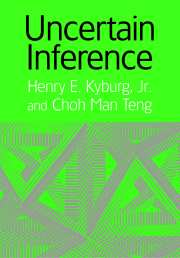Book contents
- Frontmatter
- Contents
- Preface
- 1 Historical Background
- 2 First Order Logic
- 3 The Probability Calculus
- 4 Interpretations of Probability
- 5 Nonstandard Measures of Support
- 6 Nonmonotonic Reasoning
- 7 Theory Replacement
- 8 Statistical Inference
- 9 Evidential Probability
- 10 Semantics
- 11 Applications
- 12 Scientific Inference
- Names Index
- Index
9 - Evidential Probability
Published online by Cambridge University Press: 07 December 2009
- Frontmatter
- Contents
- Preface
- 1 Historical Background
- 2 First Order Logic
- 3 The Probability Calculus
- 4 Interpretations of Probability
- 5 Nonstandard Measures of Support
- 6 Nonmonotonic Reasoning
- 7 Theory Replacement
- 8 Statistical Inference
- 9 Evidential Probability
- 10 Semantics
- 11 Applications
- 12 Scientific Inference
- Names Index
- Index
Summary
Introduction
The idea behind evidential probability is a simple one. It consists of two parts: that probabilities should reflect empirical frequencies in the world, and that the probabilities that interest us—the probabilities of specific events—should be determined by everything we know about those events.
The first suggestions along these lines were made by Reichenbach [Reichenbach, 1949]. With regard to probability, Reichenbach was a strict limiting-frequentist: he took probability statements to be statements about the world, and to be statements about the frequency of one kind of event in a sequence of other events. But recognizing that what concerns us in real life is often decisions that bear on specific events—the next roll of the die, the occurrence of a storm tomorrow, the frequency of rain next month—he devised another concept that applied to particular events, that of weight. “We write P(a) = p thus admitting individual propositions inside the probability functor. The number p measures the weight of the individual proposition a. It is understood that the weight of the proposition was determined by means of a suitable reference class, …” [Reichenbach, 1949, p. 409]. Reichenbach appreciated the problem of the reference class: “… we may have reliable statistics concerning a reference class A and likewise reliable statistics for a reference class C, whereas we have insufficient statistics for the reference class A·C. The calculus of probability cannot help in such a case because the probabilities P(A, B) and P(C, B) do not determine the probability P(A · C, B)” [Reichenbach, 1949, p. 375]. The best the logician can do is to recommend gathering more data.
- Type
- Chapter
- Information
- Uncertain Inference , pp. 200 - 229Publisher: Cambridge University PressPrint publication year: 2001



